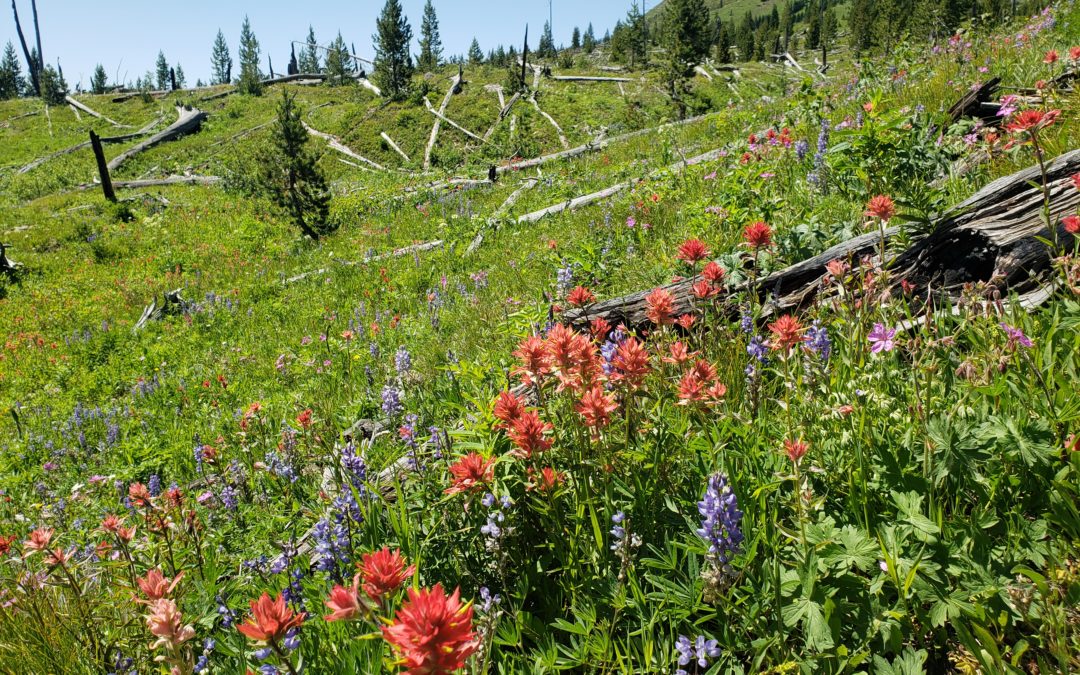
by jhwildlife | Jul 16, 2020 | Blog
By Arne Johanson
Why are our local, native plants important? Well for me, it is important that Jackson looks and feels like Jackson. If I wanted to have a suburban yard I’d be living in any suburb USA. But my opinion doesn’t really answer the question. Local native plants are important because of how they fit in with everything else here.
The local plants are adapted to grow in the local soils with only rainfall to keep them happy. Locally native plants support caterpillars. Just like Monarch Butterflies rely on milkweed, each butterfly species relies on a certain set of plants. These are the only plants on which their offspring can feed and the only plants where they will lay their eggs. The caterpillars then feed birds. Something like ninety percent of all terrestrial birds feed their young caterpillars and are reliant on this source of protein to raise their chicks.
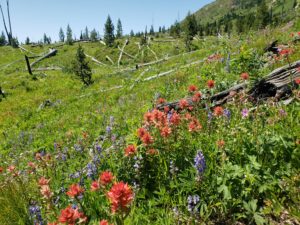
A wild bouquet of native flowers in the Yellowstone backcountry (Photo Colby Mitchell) highlights the beauty of native flora. It’s important to remember that the wildlife we love depends on native plants to survive.
Native plants also feed larger critters from chipmunk to bear, be that shoots and tubers early in the year, leaves and flowers during the summer or fruit in the fall our native plants are what the wildlife depends on.
So not only are native plant attractive to look at (personal opinion), but they are easy to grow and help provide for butterflies, birds and all the other creatures that help make this place special. Now that just might be a better answer than simply, I like Jackson and want to keep its uniqueness. Either way, our native plants are an important aspect of the valley that we call home.
EDITORS NOTE: If you’re interested in native plants and making your yard more wildlife-friendly, be sure to check out the great work of the Jackson Hole Clean Water Coalition and their Trout Friendly Lawns program!
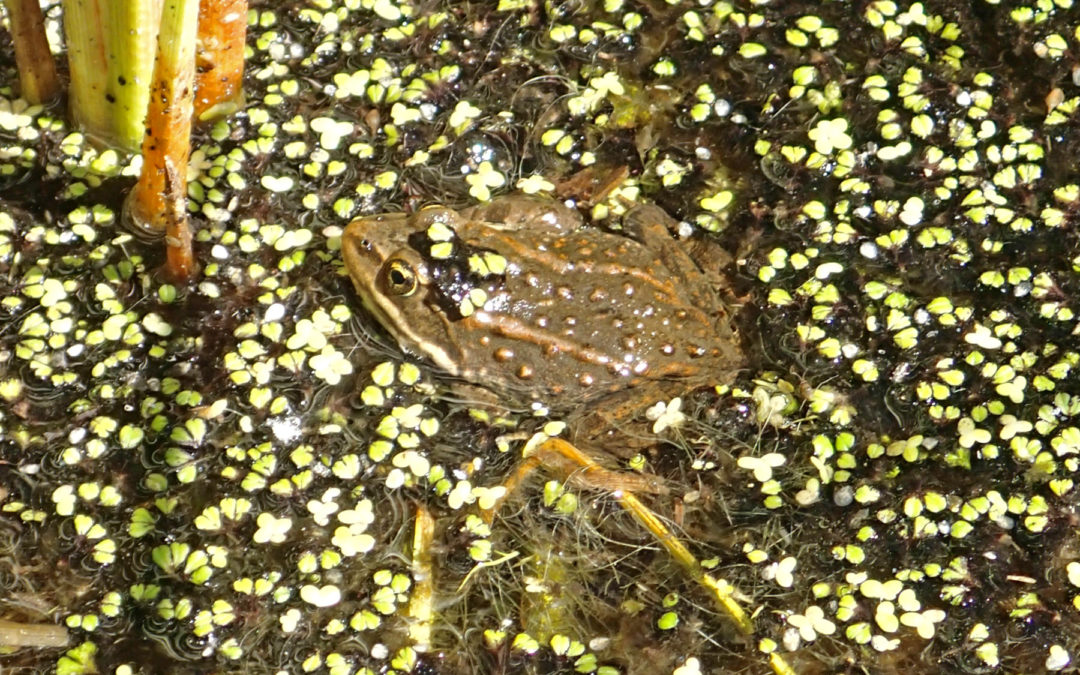
by jhwildlife | Jun 26, 2020 | Blog
By Debra Patla
The tiny Boreal Chorus Frog owns the natural soundscape of Jackson Hole wetland areas during mild weather in May and early June. Each male chorus frog sends out a trill, lasting about one second and repeated 30 or more times per minute. Each responds to the calling of its near neighbors, filling the acoustic space. Warm, moist evenings are peak performance times, with hardly a break in the continuous concert that is audible a half-mile away or more. Hard to believe these frogs are barely one inch long!
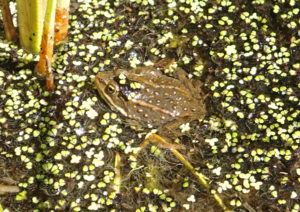
An adult Columbia Spotted-Frog, one of three species of native amphibians in Jackson Hole.
Nature Mappers, be aware that you can discern one, two, or three chorus frogs calling, but more than that confuses the ear. For a continuous chorus, all you can do is make a guess about the number and make a note about it.
A male chorus frog clams up when he succeeds in finding a female attracted to the pool by the compelling concert. Climbing on the back of the typically larger female, he wraps his front legs around her, just behind her front legs. There he clings until she excretes a clutch of eggs, which he fertilizes externally. When that’s over, he may yet have time to rejoin the chorus and find another mate.
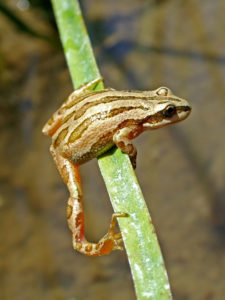
The Boreal Chorus Frog is given away by its vocalizations in the spring and early summer. It’s harder to actually catch a glimpse of one.
As summer approaches, the chorus becomes faint…solo frogs, not chorus frogs! And then, finally, silence. In that silence, much is going on. The adults migrate to summer hunting grounds in moist upland areas. The egg clusters they left behind, attached to underwater stems, hatch into tiny tadpoles that feast and rapidly grow in their forest of aquatic vegetation. Completing metamorphosis in July or early August, the little frogs emerge from the water and move upland like their parents. If all goes well, they can survive 5-7 years, returning each spring to wetlands to breed.
Two other native species in Jackson Hole have a somewhat similar life history, the Columbia Spotted Frog and the Western Toad. But their spring silence is a striking difference. One needs to be at exactly the right place and time to hear the males arguing or calling softly to females.
With luck, you will see or hear a frog or toad, or many of them, this summer. An identification guide is available at: http://www.wyomingbiodiversity.org/application/files/4015/9113/4646/AmphibianGuide_Small.pdf.
Please be sure to Nature-Map your sightings!

by jhwildlife | Apr 1, 2020 | Blog
By Kyle Kissock | Communications Manager
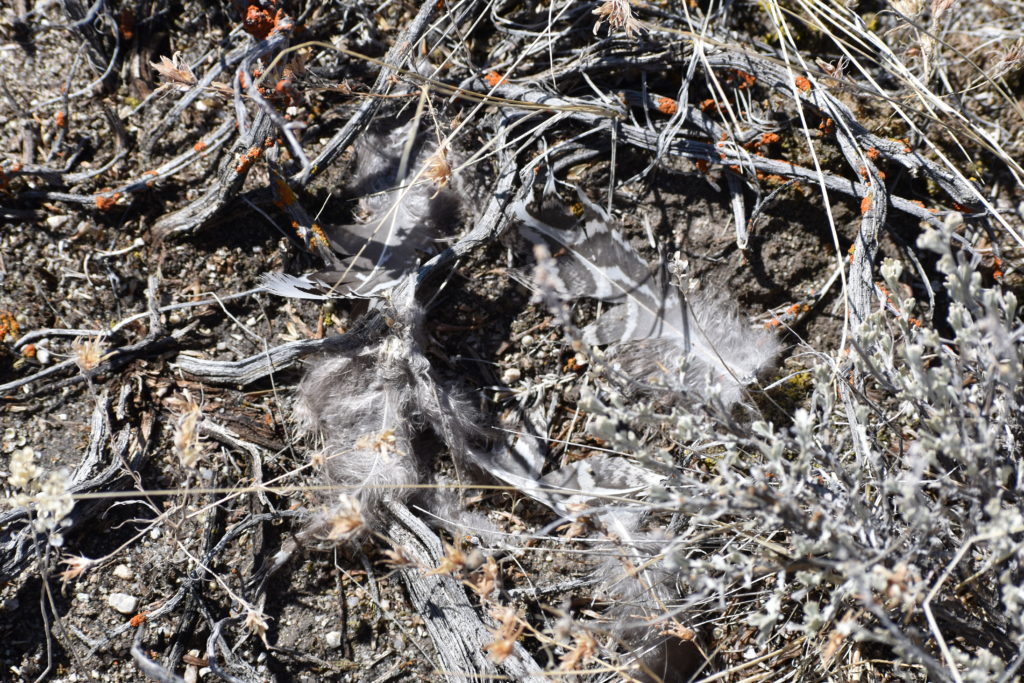
This tiny clump of feathers we found beneath a barbed-wire fence at Alkali Draw was evidence of a potential sage grouse “fence strike.”
Feathers as Clues
“I think I found a strike!” said Wes.
Beneath the fence lay a small clump of feathers – evidence, perhaps of what we’d been looking for since we’d left the trucks that morning?
The speckled down was so perfectly camouflaged with the sagebrush that I’d missed it when walking by seconds before. It was a sharp spot by Wes, who was evidently doing a better job of keeping his eyes glued to the fence line than I was.
Wes, Martin (our other volunteer) and I were surveying a two-mile long stretch of barbed-wire fence for “sage-grouse strikes” near Alkali Draw, just east of Big Piney. For the last two hours we’d waded through thigh-high sagebrush and post-holed through melting March snow drifts as we followed the fence line across the expansive open range.
We were looking for clues that would indicate the presence of a grouse strike, an unfortunate instance where a grouse collides with a barbed-wire fence in mid-flight. Strikes are more common that anyone would like in this area. While sometimes the grouse fly away unscathed, oftentimes the strike ends up being fatal, much like the fate of songbirds that slam into windows.
This smattering of feathers was the first evidence of a potential strike we’d come across that morning. Given the lengthy amount of fence we’d surveyed, finding only a single clump of feathers to this point was a good sign.
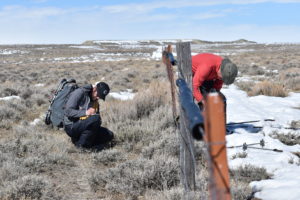
Project volunteers take field notes on the potential fence strike found on the Alkali Draw fence. The feathers were found under one of the fences we treated with black plastic loom, with the goal of making the fence’s top wire more visible to birds.
We marked our location along the fence using GPS. Although the feathers looked old (freshly melted out from under a winter’s worth of snow) we began to move outward from the feathers, methodically scanning the muddy ground for more clues that might help us determine the fate of the bird to which the clump of feathers once belonged.
The Problem: Mitigating Fence Strikes
Much of Wyoming’s whopping 43 million acres of sagebrush country serves as a refuge of sorts for the Greater Sage-Grouse.
It’s estimated that nearly 40% of the world’s Greater Sage-Grouse population occurs in the state, and perhaps no species is more inextricably linked to this specific sagebrush habitat.
But as land use has changed, Wyoming’s sage-grouse population hasn’t been exempt from dramatic declines. Over the last century the overall population of Greater Sage-Grouse in the American West has cratered nearly 95%. This is primarily due to habitat loss from human development such as farms, subdivisions, and energy infrastructure.

A victim of a fence strike. Sage-grouse most frequently collide with the top wire of barbed-wire fences, which can result in grizzly decapitations like the one pictured here.
While mortalities from fence strikes haven’t been shown to be a driving factor in the decline of grouse populations, anecdotal evidence suggests that the impacts could be significant. The fence we were surveying at Alkali Draw is one such case. It runs through an especially dense sage-grouse area, where birds flock seasonally either for mating or to forage for food.
Complicating the problem, sage-grouse are poorly adapted to recognize and avoid fences when flying. When they take to the air, grouse fly relatively low to the ground (think fence height), their wingtips nearly clipping the sagebrush.
By the time they see the fence, if they see it at all, it’s too late to react.
At Alkali Draw it’s not an uncommon sight to find signs of grouse strikes; a ball of feathers clinging to a fence, or even the full carcass of a grouse hanging on a wire if it hasn’t yet been dragged away by scavengers.
The Solution: Treatments for Fences
Back at the fence, for 10 minutes we searched the area surrounding the feathers that Wes found, but did not find additional signs of the bird that left its mark. This was to be expected as the strike was old and had it resulted in a mortality, remnants of the dead bird would likely be long gone.
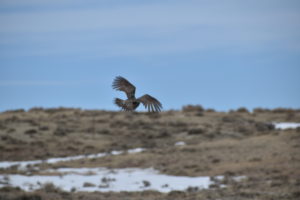
Our approaching footsteps spooked this female grouse near the Alkali Draw Fence.
Given that the feathers were found directly under the barbed-wire, we determined this was evidence of a fence strike. After making note that the feathers were found under the section of barbed-wire that we’d treated with black plastic loom, we carried down the fence line.
The Alkali Draw fence is actively used to contain livestock and cannot be permanently removed. But in seeking a solution to mitigate strikes in the area, we had applied a series of treatments to the fence that make its wires more visible to airborne grouse. The “black plastic loom” was one of the treatments we were studying.
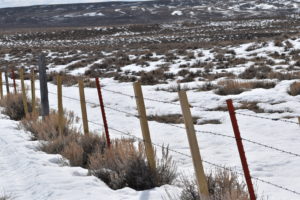
An example of the wooden stays “treatment” applied to the fence to make it more visible to grouse. Note the visible wooden posts we installed on the wire in between the standard metal t-posts.
Last year, the Jackson Hole Wildlife Foundation partnered with the Bureau of Land Management (BLM) to apply multiple treatment types to barbed-wire fences outside of Pinedale, where grouse strikes are recurring issues.
Our goal is to conduct a long-term study over multiple seasons to explore which treatment type works best to reduce grouse strikes. Teton Raptor Center is the project’s partner responsible for crunching the data points and analyzing the effectiveness, or lack thereof, for each fence treatment.
The study design is simple; at each study site each treatment type covers roughly ¼ mile of fence and treatments are as follows:
1. Black plastic loom on the top wire
2. White plastic loom on the top wire
3. Mixed loom (black and white) on the top wire
4. Wooden “stays” installed vertically on the fence
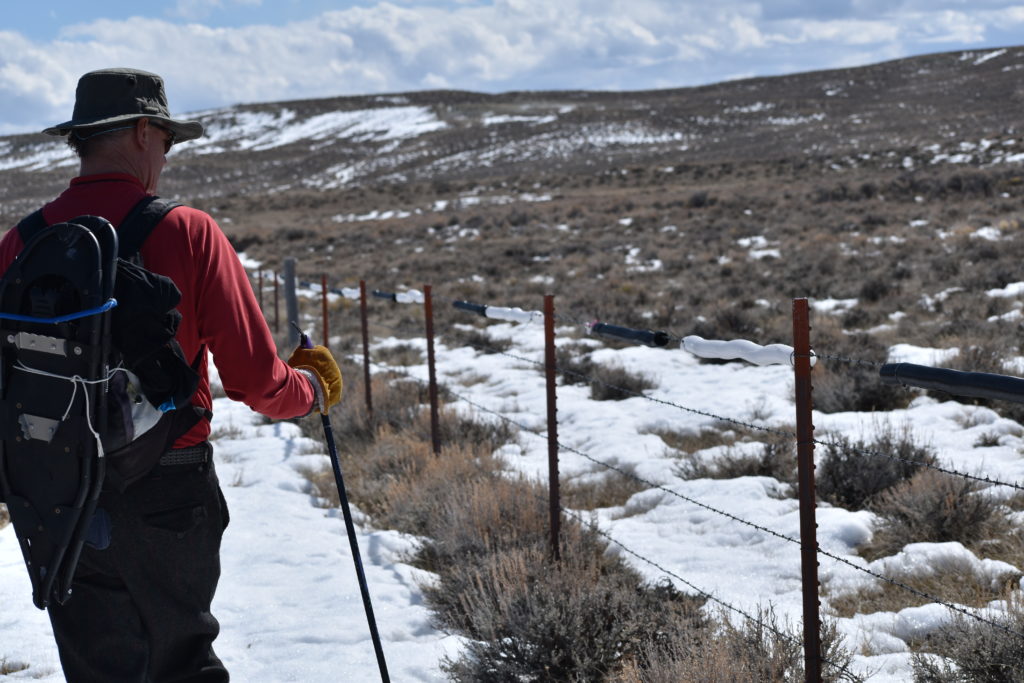
A volunteer surveys the Alkali Draw fence for strikes in the “mixed loom” treatment section. Both black and white plastic loom has been installed on the top wire to maximize visibility in all weather conditions.
Our plan is to work with the BLM to survey five miles of fence on a bi-weekly basis through the winter and spring to record the number of strikes and mortalities that occurs in each treatment area.
At each study site we leave a portion of barbed-wire untreated as a control in the experiment. If over time, and with the help of Teton Raptor Center’s research director, we determine that there is a statistically significant difference between the amount of strikes in the control segments and our treatments, we’ll be able to recommend a preferred treatment and application to fences where high-levels of strikes are occurring.
Data collection for the 2020 season is just starting, so stay tuned for updates on what’s working and why!

by jhwildlife | Mar 20, 2020 | Blog
By Troy Koser | PhD Candidate, Montana State University
Dear Nature Mappers,
Do you love moose and frequently see them in or around your home?
If so, we would like for you to consider participating in a scientific project studying the interactions between moose, winter ticks, and climate in the Jackson Hole area.
We are specifically looking for landowners to grant researchers access to their properties so that they can collect data on winter ticks and moose health.
The project is also looking for participants who would be willing to have researchers erect experimental plots with ticks that would be monitored from Spring 2020-Fall 2020.
The details of the project are explained in this Moose Citizen Science Engagement document and the U.S. Geological Service permission forms for both studies are included here (first study), and here (second study).
The “Exp Plot and Surveys” permission form grants permission for both study components while the “Surveys” permission form only grants access to collect sample, but not establish an experimental plot.
Thank you for your consideration and time. Please feel free to contact me, Troy Koser, with any questions about the project or winter tick-moose interactions in general!
Best,
Troy Koser
PhD Student at Montana State University
Bozeman Disease Ecology Lab
School Email: troykoser@montana.edu
Personal Email: troykoser13@gmail.com
Cell: 5013582807
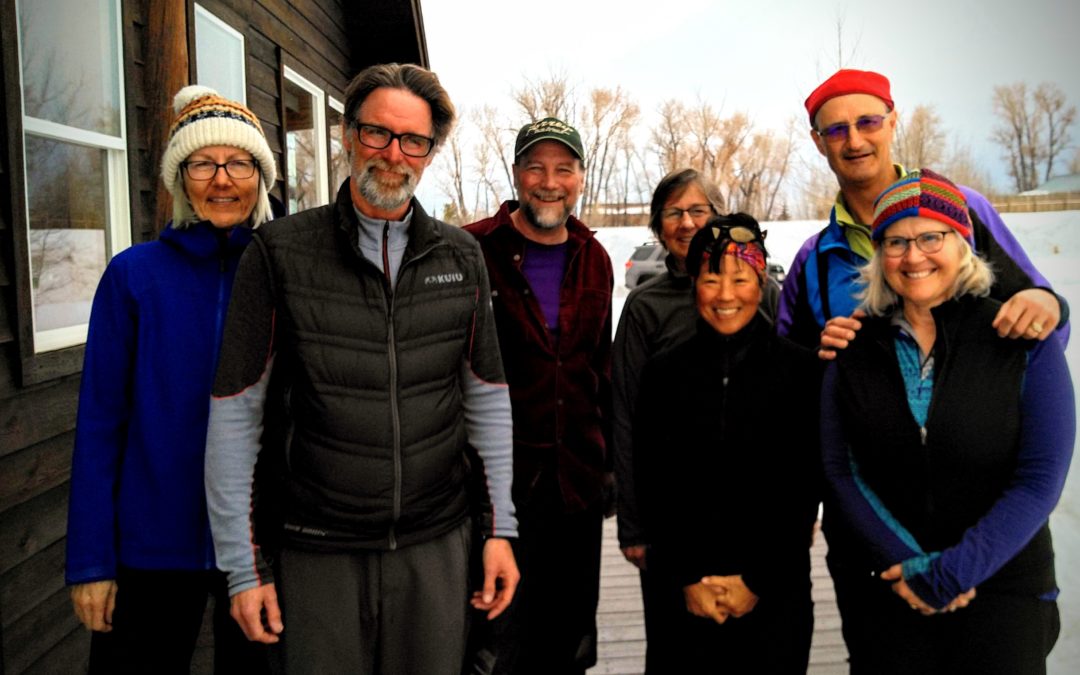
by jhwildlife | Mar 19, 2020 | Blog
By Frances Clark | Lead Nature Mapping Volunteer
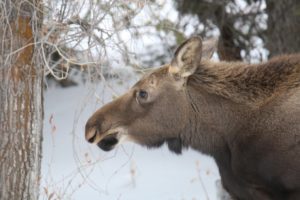
This healthy-looking young moose was photographed by GTRE staff participant Sarah Dewey, browsing in a cottonwood grove.
The data is in: 127 moose, 100 volunteers in 32 teams, who donated over 350 hours! Wow, thank you all. Teams ranged north to Arizona Creek in Grand Teton National Park, east out the Gros Ventre, west to Alta, and south to the county border.
Click here for our Moose Day sightings map!
The total number of moose fits in with two other peak years: 127 in 2019, and 124 in 2011, which were extreme snow years that concentrated moose into the valley near roads and homes for easier movement.
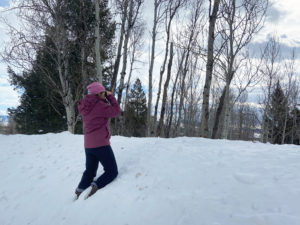
Tamara Clausen uses binoculars to survey for moose. This year’s weather made for easier critter-finding than in 2019, when blizzard conditions and tall snow banks complicated search efforts. Photo: Frances Clark.
This year, with temperatures in the mid 30s and mostly sunny, it was good weather for humans scouting for moose, although less good for moose, which are adapted to extreme cold and begin to stress at temperatures over 23 degrees.
We had a whopping 172 moose in 2017, due to 57 out the Gros Ventre to the Darwin Ranch. This year the U.S. Forest Service team headed by Jason Wilmot snowmobiled to the Darwin Ranch and saw 39 moose.
In addition, we had a record number of volunteers: 100 up from 92 last year, which was then the all-time high. We had a several family teams and teams of new Nature Mappers. Thank you!
We particularly appreciate John Beller who trained and deployed eight volunteers in a new area around Alta, on the west side of the Tetons. They saw one moose.
Reports noted moose in great shape with glossy coats. Rarely did mappers observe injuries, and no rubbed fur (a sign of ticks) or nicked ears (a sign of carotid artery worms).
In general moose appeared at certain nodes – Buffalo Valley (16), out the Gros Ventre (39), a subdivision west of the airport (11), off the south dike in Wilson (8), and around Trail Creek/Old Pass Road region (16).

This volunteer team of cross-country skiers surveyed a large territory consisting of Ditch Creek, the Gros Ventre River, and Antelope Flats. Photo: Kathy McCurdy.
They were more scattered elsewhere throughout the valley requiring patience and in some cases causing disappointment. Several teams saw fresh tracks but no moose, and other teams saw no trace of moose. As we often say, “The moose disappear on Moose Day.” We don’t know why or where.
On Moose Day there were many other critters to nature map: coyotes, fox, otter, Pacific marten, ermine, bison, and elk, along with various birds: Bald Eagles, Trumpeter Swans, Common Mergansers, Ring-Necked Ducks, and “first-of-the-year” Red-winged Blackbirds.
We thank Wyoming Game and Fish, Grand Teton National Park, Bridger-Teton National Forest, and the National Elk Refuge for their contribution of staff time to the cooperative cause of Moose Day. And we thank all of you who snowshoed, skied, drove, and snowmobiled for hours. Finally, particular appreciation to the private landowners including the Resor Family, Jackson Hole Golf and Tennis, Teton Science School, among others for granting permission to survey their property.
Below are excerpts from individual team reports:
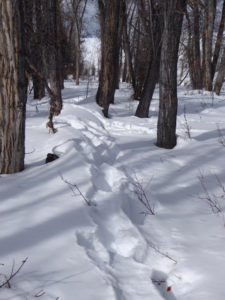
Old moose tracks in a cottonwood gallery, a common site for many participants surveying riparian areas on Moose Day. Photo: Kathy McCurdy.
In the north part of the park Moran junction to Arizona Creek, Kate Winters, her mother Nancy Winters, and Jon Wiedie observed coyote, ermine, a skier, an old snowshoer, and rodent tracks around Oxbow Bend. Skiing south of the roadway between oxbow and dam, they found two female moose, an adult and juvenile, who had been hanging around cottonwoods and crossing over to hide in the evergreens.
Covering her part by ski, Deb Patla saw one set of old moose tracks near the end of that jaunt, mostly covered by fresh or wind-blown snow. She saw swans, bald eagles, and lots of coyote, fox and ermine tracks.
Matt Fagan and Karyn Greenwood snowshoed five hours around Pacific Creek with no moose in sight, which puzzled him as he sees them regularly there in the summer. He was rewarded though by a couple of Buffleheads and Bald Eagles over the Snake River, and four Mountain Chickadees; also lots of tracks of fox, coyote, and otter!
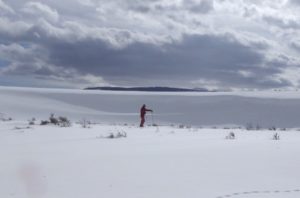
Ray White surveys a terraced snowscape in Grand Teton National Park. Photo: Kathy McCurdy
Grand Teton Park biologists Sarah Dewy and Carson Butler found the motherload of 16 moose in the Buffalo Valley – good willow habitat!
Bev Boynton, Ray White, Kathy McCurdy, and Nancy Shea were surprised to find only four moose in their area covering Antelope Flats, the Gros Ventre river bed, road east of Kelly, and north along Ditch Creek to the Teton Science School’s Kelly Campus.
While there was plenty of sign, they saw only two moose up Ditch Creek eating cottonwoods. They saw plenty of other species including 70 elk walking on the Kelly Peak massif; Red-wing Blackbirds, Barrow’s Goldeneye, four geese at Kelly Warm Springs (“First of Year for us”) along with five bison, two swans, five Common Mergansers, 10 Ring-necked Ducks.
Two teams of two under the aegis of U.S. Forest Service biologist Jason Wilmot, snowmobiled 6.5 hours to find 39 moose along the Gros Ventre Road out to the Darwin Ranch.
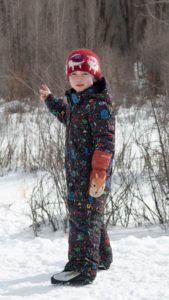
Moose Day 2020’s youngest Nature Mapper? Photo: Taylor Phillips.
A team of Jackson Hole natives Leith and Barb Barker and Reade and Dave Dornan reported, “Several places of good moose tracks, which we really scoured with our four sets of binoculars, but nary a twig eaten did we spy, not even an ear tip. And nobody we approached saw moose either. We asked photographers, eco-tour drivers, cross-country skiers, and a bartender (at Moose). Nobody has seen a moose in ‘a couple of weeks.’ Alas . . . we were moose-less. Sigh. Hope others had better luck!”
To the west and north of the airport, Steven Squillaci and family cruised in an SUV to find 11 moose in a subdivision clustered along two roads, a sign of likely feeding. Unfortunately, feeding moose can be harmful as their gut may not be adapted to digesting the well-meaning handouts.
A team covered the region around Jackson Golf and Tennis (JHGT) by snowmobile, car, and ski to see five moose. The team included JHGT manager Jeff Jensen and Randy and Robin Reedy, who postponed a trip to participate in Moose Day!
Thanks to permission from the Resor Family, a team of six skied much of the Snake River Ranch, (“It was pretty rough!”) and two drove around the Snake River Ranch. Unfortunately no moose but David Watson and daughter Taylor Woods watched a Pacific Marten for 5-6 minutes. Bruce Pasfield saw two coyotes, and Ben Wise and company saw four individual foxes. “It was great to get out this morning!”
Jana Stearns and Kerri Ratcliff skied down the length of Old Pass Road, finding no moose there, but one at the cemetery and another few nearby. Jeremy Schmidt tramped around the woods with no luck. A neighbor provided a report of 11 moose.
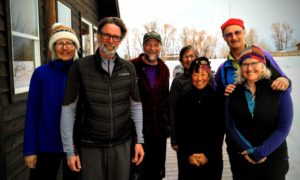
Cheerful Moose Day volunteers after a morning of searching for moose. Photo John Beller.
The riparian area along the Snake River was scouted by three teams: Taylor and Brook Phillips are starting their son Canyon (above) and daughter Isa off early as naturalists, to find a cow/calf pair along the “north dike.” Susan Marsh, Meg Gilbert, and Julie Holding saw eight moose along the “south dike” in Wilson. AJ DeRosa deployed three teams of two to cover the extensive area around his “tipi camp” in the cottonwoods for one moose sighting.
Patty Ewing and daughter Heather covered Cache Creek for three moose that they know well, marking their movements throughout the day (most were loafing).
Many, many more of you covered neighborhoods of Wilson, Teton Village, Jackson, High School Road, South Park, Game Creek, and way south to the county border. Again, thank you for your time, enthusiasm, and commitment to the moose we all care for!
![]() Frances Clark, Moose Day Coordinator
Frances Clark, Moose Day Coordinator
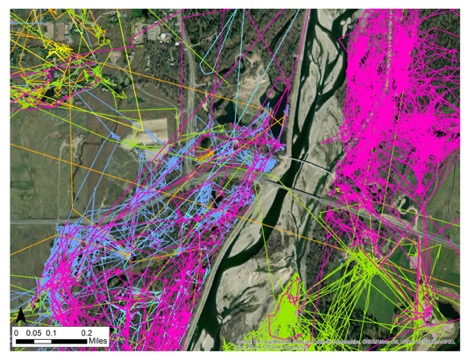
by jhwildlife | Feb 7, 2020 | Blog
By Aly Courtemanch, Wildlife Biologist | Wyoming Game and Fish Department
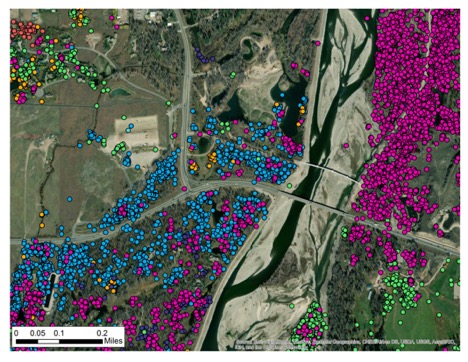
Collared moose GPS locations in the vicinity of the Snake River Bridge and Highway 22/390 intersection from March 2019 – January 2020. Each color corresponds to an individual collared moose. The GPS collars collect a point every 30 minutes.
Moose are one of the most beloved wildlife species by our community. During the winter, they become more easily observable when they migrate down to low elevations and are often seen right in our neighborhoods and backyards. However, living amongst humans and our development can be dangerous too. The number of moose-vehicle collisions on roads have steadily increased in recent years in Teton County.
For this reason, the Wyoming Department of Transportation and Wyoming Game and Fish Department partnered in 2019 to learn more about when, where, and how often moose cross roads. In March 2019, we darted 10 cow moose within 3 miles of the Snake River Bridge and Highway 22/390 intersection and fit them with satellite tracking collars. These collars are programmed to collect a GPS location every 30 minutes and will stay on the moose for 2 ½ years, at which point they will automatically detach and drop off. The collars upload their GPS locations every 2 days to a satellite, which then sends the locations to an email account where we can download them. This technology allows us to get real-time data on moose movements and be alerted to possible mortalities.
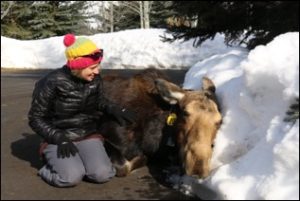
Kate Gersh, Associate Director Jackson Hole Wildlife Foundation, sits with an anaesthetized cow moose while she wakes up.
This is the first time that moose have been collared in this area so we are learning new and very interesting things about their movements. We have learned that four of the 10 moose are migratory, meaning that they moved from their low elevation winter ranges where they were collared to high elevation summer ranges. One of the collared moose spent the summer in Grand Teton National Park in Open Canyon and Death Canyon. The other migratory moose spent the summer in Phillips Canyon and Teton Pass. Six of the 10 moose are resident, meaning that they used generally the same areas in the summer and the winter. Resident moose mostly spent the summer on West Gros Ventre Butte, around the Wilson area, and along the Snake River, Fish Creek, and Fall Creek.
We have also learned that some moose cross roads a lot, whereas others cross very infrequently. Two moose have only crossed Highway 22 or 390 once or twice during the past 10 months. Other moose have crossed 27, 34, and 67 times! So far, only one collared moose has died. She died of unknown causes but had not crossed any roads while she was collared, so her death was not caused by a vehicle collision. The moose collar data has already provided important information about where wildlife underpasses should be located as part of WYDOT’s Snake River Bridge replacement project, which is expected to start construction in 2022.

Collared moose movements in the vicinity of the Snake River Bridge and Highway 22/390 intersection from March 2019 – January 2020. Each color corresponds to an individual collared moose. The lines shown on this map connect the 30 minutes points seen on the previous map.
This project has received a HUGE amount of support from our community! In addition, many new funding partners have contributed money this year to expand this study. Thanks to this help, we plan to dart and collar eight more cow moose in March 2020 and partner with other researchers to study how diseases and parasites (winter ticks) are affecting moose.
I want to extend a huge thank you to all of the private landowners who allowed us access to their property to dart and collar these moose! Thank you to our funding partners: Wyoming Department of Transportation, Teton Conservation District, Greater Yellowstone Coalition, U.S. Geological Survey, Teton County, and Veterinary Initiative for Endangered Wildlife.
























